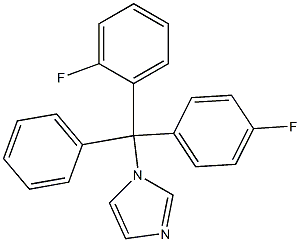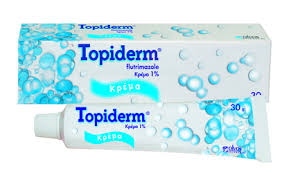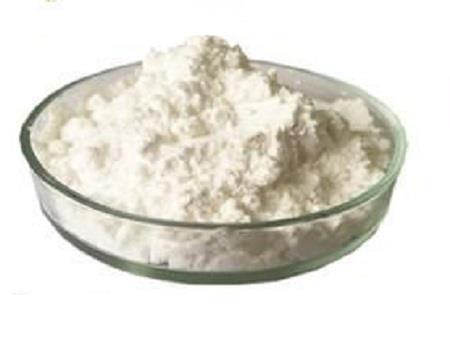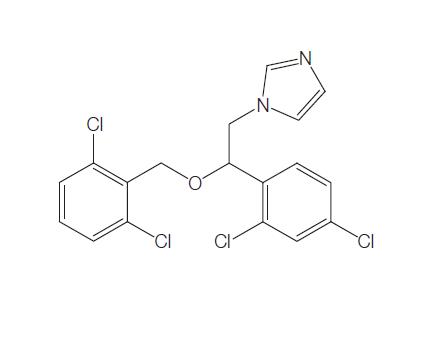Pharmacodynamics and Toxicity of Flutrimazole
Flutrimazole is an imidazole derivative with the chemical name 1- [o-fluoro-a-(p-fluorophenyl)-a-phenylbenzyl]imidazole; the chemical structure is shown in Figure 148.1. Flutrimazole has a broad spectrum of antifungal activity in vitro and has been shown to be an effective agent for the management of dermatomycoses and vaginal candidiasis.
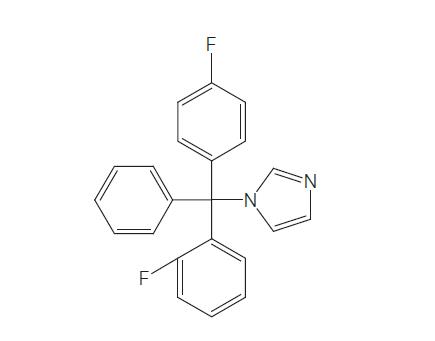
Mechanism of action
The mechanism of action of flutrimazole is shared with the other azoles, that is, inhibition of fungal lanosterol 14a-demethylase. It strongly inhibits ergosterol biosynthesis in a cell-free homogenate of C. albicans, with an IC50 value of 0.071 mmol/l.
Pharmacokinetics and Pharmacodynamics
Flutrimazole has minimal transdermal penetration and long (24 hours) skin retention. The amount of flutrimazole retained per gram of skin is more than 100 times the MIC obtained in in vitro studies of dermatomycotic pathogens. Flutrimazole has not been detected in plasma, urine, or feces following topical application. Local tolerance is excellent and flutrimazole has been shown to have anti-inflammatory properties, similar to ketoconazole, in animal models.
Toxicity
Flutrimazole is very well tolerated with local itching or burning in less than 5% of subjects. Furthermore, it lacks sensitizing potential, is devoid of phototoxic potential, and does not induce photoallergic reactions.
Dermatomycosis In a comparative trial, flutrimazole 1% cream was more effective than bifonazole 1% cream (73% vs 65%, respectively), each used once daily, in the treatment of dermatophytosis, cutaneous candidiasis, and pityriasis versicolor. Similarly, flutrimazole 1% cream is as effective as ketoconazole 2% creamand clotrimazole 1% cream in the treatment of dermatomycoses. In the case of interdigital tinea pedis, complete cure rates of 78–88% have been documented with daily applications of flutrimazole for 3–4 weeks, similar to those obtained with bifonazole. Flutrimazole has also been shown to have similar efficacy to ketoconazole in the treatment of pityriasis versicolor and seborrheic dermatitis.
A double-blind, randomized, comparative phase II study of flutrimazole site-release vaginal cream at three different doses (1%, 2%, and 4%) versus placebo was undertaken in women with acute vulvovaginal candidiasis. At the assessment 9 days after the end of therapy, clinical cure was observed in 82%, 87.4%, and 83.8% in women receiving flutrimazole 1%, 2%, and 4% cream, respectively. This was superior to that observed with placebo (63.5%). At the assessment 4 weeks after the end of therapy, a clear dose effect of flutrimazole site-release cream was apparent: 60.6%, 78%, and 80.6% cure in those receiving 1%, 2%, and 4% cream, respectively (48.4% placebo).
Tolerability was excellent with all formulations; however, flutrimazole 2% was chosen for future clinical use because of its slightly better tolerance profile and comparable efficacy to the 4% cream. Notably, there was a significant association between C. glabrata and treatment failure and also carrier state, suggesting that flutrimazole may not be optimal for treating vulvovaginitis due to this species.
Related articles And Qustion
See also
Lastest Price from Flutrimazole manufacturers
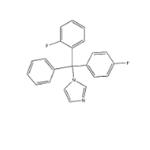
US $1.10/g2025-10-01
- CAS:
- 119006-77-8
- Min. Order:
- 1g
- Purity:
- 99.9%
- Supply Ability:
- 100 Tons Min
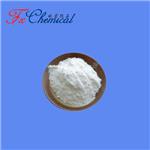
US $0.00-0.00/G2025-04-21
- CAS:
- 119006-77-8
- Min. Order:
- 1G
- Purity:
- 98.0%
- Supply Ability:
- 10kg/month
